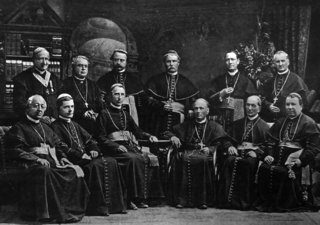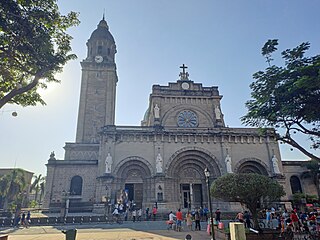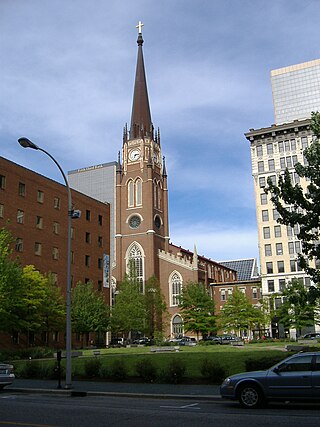Religion in Cheshire, and, in particular, Christianity, has a long history. In the 2001 census, however 1 in 5 people either were recorded as no religion or religion not stated. [1] The boundary of the Church of England Diocese of Chester currently follows most closely the pre-1974 county boundary of Cheshire, so it includes all of Wirral, most of Stockport, and the Cheshire panhandle, that included Tintwistle Rural District council area. [2] In terms of Roman Catholic church administration, the majority of Cheshire falls into the Roman Catholic Diocese of Shrewsbury. [3] Cheshire still has a slightly higher proportion of Christians than the rest of the North West of England. [1]
There is an Islamic organisation in Cheshire called Islamic Forum Cheshire it is affiliated to the Muslim Council of Britain. [4]
In Cheshire there were number of Jewish congregations some of which were set up by World War II evacuees [5] the only remaining is Chester Hebrew Congregation. [6] In Cheshire there is also a Jewish Primary School called North Cheshire Jewish Primary School. [7]
There are a number of Buddhist centres in Cheshire, including Kagyu Buddhism Cheshire, [8] and Odiyana Buddhist Meditation Centre which provides classes in Buddhism throughout the county. [9]
In Warrington there is a Sikh Gurdwara called Guru Nanak Gurdwara Sikh Temple built by the Indian community in Cheshire. [10]
According to the 2001 Census, the religious group breakdown in Cheshire was: [1]
| Religion | Chester | Congleton | Crewe and Nantwich | Ellesmere Port and Neston | Macclesfield | Vale Royal | Total |
|---|---|---|---|---|---|---|---|
| Christian | 92,377 (78.1%) | 73,844 (81.5%) | 89,080 (80.2%) | 67,396 (82.5%) | 119,508 (79.6%) | 100,208 (82.1%) | 542,413 (80.5%) |
| Buddhist | 236 (0.2%) | 107 (0.1%) | 151 (0.1%) | 108 (0.1%) | 292 (0.2%) | 200 (0.2%) | 1,091 (0.2%) |
| Hindu | 206 (0.2%) | 97 (0.1%) | 129 (0.1%) | 65 (0.1%) | 391 (0.3%) | 123 (0.1%) | 1,010 (0.1%) |
| Jewish | 132 (0.1%) | 52 (0.1%) | 48 (0.0%) | 40 (0.0%) | 459 (0.3%) | 52 (0.0%) | 798 (0.1%) |
| Muslim | 630 (0.5%) | 154 (0.2%) | 459 (0.4%) | 212 (0.3%) | 767 (0.5%) | 211 (0.2%) | 2,433 (0.4%) |
| Sikh | 65 (0.1%) | 34 (0.0%) | 46 (0.0%) | 27 (0.0%) | 86 (0.1%) | 73 (0.1%) | 333 (0.0%) |
| All other religions | 197 (0.2%) | 141 (0.2%) | 165 (0.1%) | 62 (0.1%) | 283 (0.2%) | 176 (0.1%) | 1033 (0.2%) |
| No religion | 15,342 (13.0%) | 10,389 (11.5%) | 13,222 (11.9%) | 8,340 (10.2%) | 19,146 (12.8%) | 13,315 (10.9%) | 79,754 (11.8%) |
| Religion not stated | 9,024 (7.6%) | 5,828 (6.4%) | 7,707 (6.9%) | 5,407 (6.6%) | 9,225 (6.1%) | 7,732 (6.3%) | 44,923 (6.7%) |

A temple is a building reserved for spiritual rituals and activities such as prayer and sacrifice. Religions which erect temples include Christianity, Hinduism, Buddhism, Sikhism, Jainism, Islam, Judaism, Zoroastrianism, the Baha'i Faith, Taoism, Shinto, Confucianism, and ancient religions such as the Ancient Egyptian religion and the Ancient Greek religion.

Clergy are formal leaders within established religions. Their roles and functions vary in different religious traditions, but usually involve presiding over specific rituals and teaching their religion's doctrines and practices. Some of the terms used for individual clergy are clergyman, clergywoman, clergyperson, churchman, ecclesiastic, and cleric, while clerk in holy orders has a long history but is rarely used.

A missionary is a member of a religious group which is sent into an area in order to promote its faith or provide services to people, such as education, literacy, social justice, health care, and economic development.

Worship is showing regard with great respect, honor, or devotion. This may be encountered in religious settings. In such instances it may represent divine worship; reverence for a divine being or supernatural power. This activity may have other focuses, such as hero worship. Worship may involve one or more of activities such as veneration, adoration, praise, supplication, devotion, prostration, or submission. An act of worship can be performed as simple prayer or through elaborate ceremony, individually, in an informal or formal group, or by a designated leader. The focus of worship is ultimately honoring the subject in some manner.

Christianity is the predominant religion in the Philippines, with Roman Catholicism being its largest denomination. Sizeable minorities adhering to Islam, Indian religions, and indigenous Philippine folk religions are also present.

A place of worship is a specially designed structure or space where individuals or a group of people such as a congregation come to perform acts of devotion, veneration, or religious study. A building constructed or used for this purpose is sometimes called a house of worship. Temples, churches, mosques, and synagogues are examples of structures created for worship. A monastery may serve both to house those belonging to religious orders and as a place of worship for visitors. Natural or topographical features may also serve as places of worship, and are considered holy or sacrosanct in some religions; the rituals associated with the Ganges river are an example in Hinduism.

British society is one of the most secularized in the world and in many surveys determining religious beliefs of the population agnosticism, nontheism, atheism, secular humanism, and non-affiliation are views shared by a majority of Britons. Historically, it was dominated for over 1,400 years by various forms of Christianity, which replaced preceding Romano-British religions, including Celtic and Anglo-Saxon paganism. Religious affiliations of United Kingdom citizens are recorded by regular surveys, the four major ones being the national decennial census, the Labour Force Survey, the British Social Attitudes survey and the European Social Survey.

The term American Buddhism can be used to describe all Buddhist groups within the United States, including Asian-American Buddhists born into the faith, who comprise the largest percentage of Buddhists in the country.
Modern-day Birmingham's cultural diversity is reflected in the wide variety of religious beliefs of its citizens. In the 2021 census, 70% of residents identified themselves as belonging to a particular faith, while 24% stated they had no religion and a further 6% did not answer the question.
Religion in Hong Kong is characterised by a multi-faith diversity of beliefs and practices.

Prayer beads are a form of beadwork used to count the repetitions of prayers, chants, or mantras by members of various religions such as Hinduism, Buddhism, Shinto, Umbanda, Islam, Sikhism, the Baháʼí Faith, and some Christian denominations, such as the Roman Catholic Church, the Lutheran Church, the Oriental Orthodox Churches, and the Eastern Orthodox Churches. Common forms of beaded devotion include the mequteria in Oriental Orthodox Christianity, the chotki in Eastern Orthodox Christianity, the Wreath of Christ in Lutheran Christianity, the Dominican rosary of the Blessed Virgin Mary in Roman Catholic Christianity, the dhikr in Islam, the japamala in Buddhism and Hinduism, and the Jaap Sahib in Sikhism.

Diamond Way Buddhism is a lay organization within the Karma Kagyu school of Tibetan Buddhism. The first Diamond Way Buddhist center was founded in 1972 by Hannah Nydahl and Ole Nydahl in Copenhagen under the guidance of Rangjung Rigpe Dorje, 16th Karmapa. Today there are approximately 650 centers worldwide, directed by Ole Nydahl under the guidance of Trinley Thaye Dorje, one of two claimants to the title of the 17th Karmapa. Buddhist teachers such as Sherab Gyaltsen Rinpoche, Lama Jigme Rinpoche and Nedo Kuchung Rinpoche visit Diamond Way Buddhism centers and large meditation courses.
London has centres of worship for many faiths. According to the 2021 Census, the largest religious groupings are Christians (40.66%), followed by those of no religion (27.05%), Muslims (14.99%), no response (7%), Hindus (5.15%), Jews (1.65%), Sikhs (1.64%), Buddhists (1.0%), and others (0.9%).

Christianity is the largest religion in England, with the Church of England being the nation's established state church, whose supreme governor is the monarch. Other Christian traditions in England include Roman Catholicism, Methodism and the Baptists. After Christianity, the religions with the most adherents are Islam, Hinduism, Sikhism, Judaism, Buddhism, modern paganism, and the Bahá'í Faith. There are also organisations promoting irreligion, including humanism and atheism. According to the 2021 census, Shamanism is the fastest growing religion in England.

The main religion in Tibet has been Buddhism since its outspread in the 8th century AD. As of 2022 the historical region of Tibet is mostly comprised in the Tibet Autonomous Region (TAR) of China and partly in the Chinese provinces of Qinghai and Sichuan. Before the arrival of Buddhism, the main religion among Tibetans was an indigenous shamanic and animistic religion, Bon, which would later influence the formation of Tibetan Buddhism and still attracts the allegiance of a sizeable minority of Tibetans.

Religion in Louisville, Kentucky, includes religious institutions of various faiths; including Christianity, Judaism, Islam, Hinduism, Buddhism and Sikhism.
Throughout its history the city of Houston, Texas has been religiously influenced by Protestant Christianity in the Bible Belt. Since the latter half of the 20th century, the Houston area has become home to many different religions in part to its large ethnic diversity, immigration, and refugee resettlement.
Even though the government of Oman does not keep statistics on religious affiliation, statistics from the CIA World Factbook state that adherents of Islam are in the majority at 95%, with Christianity, Hinduism, Buddhism, and Judaism less than 5%. Other religious affiliations have a proportion of 1% and the unaffiliated only 0.2%.